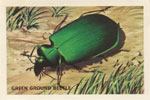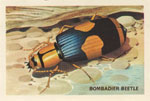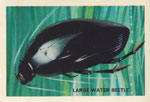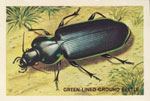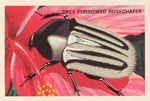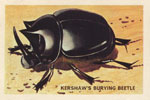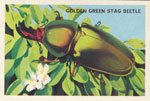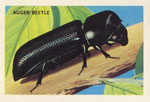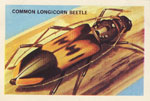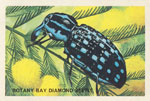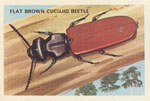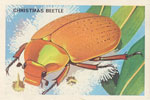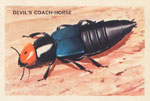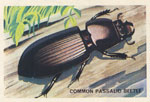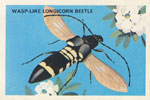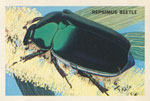Beetles in the Gardens
These illustrations and accompanying descriptions were published in Shell's Picture Card Album of Australian Beetles. Those reproduced below are likely to be found in the ACT. Thanks to Tom Weir, CSIRO Entomology, for providing advice on distribution and scientific names. Where necessary these names have since been updated to match those accepted by the Australian Faunal Directory (AFD) and linked to the AFD entries. Click on the illustrations to enlarge.
Images and text © Shell Company of Australia Ltd with permission. Scanning of images by volunteer Margaret Boots.
For more information on Australian beetles, visit the CSIRO's Australian Insect Families Coleoptera page.
Green Ground Beetle (Calosoma schayeri)This beetle, metallic-green in colour is a very common variety. It is sometimes found even in the streets of Melbourne and other Southern Australian cities. When captured and held in the fingers, this beetle emits a strong odour resembling that of carbolic acid. The green ground beetle is a species of the family Carabidae, and its larvae prey on insects. |
|
Bombardier Beetle (Pheropsophus verticalis)A member of the family Carabidae, it is a ground beetle and one that defends itself by ejecting a fine spray of offensive liquid when disturbed or annoyed. It gets its name from this capability. Nocturnal in habits, it generally hides by day under stones, bark, etc. This beetle is more common in the Northern States but is found also in Northern Victoria and South Australia. |
|
Banksia Longicorn Beetle (Uracanthus triangularis)This is an interesting beetle which is very common in South-Eastern Australia. Its grubs, or larvae, bore into native honeysuckle or banksia trees, often eventually causing large branches to die and fall. Adult beetles are found during the warmer months, and in some areas are very plentiful and easily discovered basking in the hot sun. |
|
Large Black Water Beetle (Hydrophilus latipalpus)This interesting beetle is one of the largest of our water beetles and is found mainly in Tasmania, Victoria and southern New South Wales. Its larvae live in water, where they prey on other water organisms. At times, large numbers of these insects may be attracted from their natural water habitat to artificial lights. This beetle is of the family Hydrophilidae, and its larvae are predatory. |
|
Giant Christmas Beetle (Anoplognathus viridiaeneus)This is probably the largest of that section of our insects known as Christmas Beetles. It is common in the bushland around Sydney and the north coast of New South Wales. Essentially a summer insect, it appears on the foliage of eucalyptus trees; where one is found you can be certain there will be others on the same tree. |
|
Green Lined Ground Beetle (Catadromus lacordairei)This fine large beetle with the metallic green line around the sides of its wing cases belongs to the Carabidae family and is an inhabitant of the drier areas of Australia. It is fairly common in the Mallee of north-western Victoria and in similar country of N.S.W. and South Australia. The grubs (larvae) of this beetle are carnivorous, feed on lesser grubs. |
|
Grey Furrowed Rosechafer (Trichaulax philipsii)This is one of the Scarabaeidae family, and a very interesting Rosechafer Beetle because the furrows on its wing covers are densely hairy. It occurs in Victoria, N.S.W. and Queensland and, like others of its family, feeds from the nectar of native flowering trees and shrubs. Its grubs feed and breed in rotting logs of most varieties of eucalypts. |
|
Kershaw's Burying Beetle (Onthophagus mniszechi)This is one of the most common of the Cockchafer type of beetles - found mainly in the southern Australian States. It buries fresh manure and forms it into an oval cell to accommodate the larvae. It is of the family Scarabaeidae. Holes made by this insect may often be found under pads of fresh cow manure. |
|
Golden Green Stag Beetle (Lamprima latreillii)This beetle is one of our most brilliantly-coloured and beautifully-shaped species. It is found during the warmer months of the year in Victoria, New South Wales and Queensland. Its family is Lucanidae and the adult beetle may often be seen at rest on the foliage of trees. The male is larger than the female and has longer jaws. The larvae breed in rotting wood. |
|
Auger Beetle (Bostrychopsis jesuita)This black, rather blunt-backed beetle is found all over the mainland of Australia during the warmer months of the year. Its grubs are often serious pests in various kinds of native timber, where their borings resemble holes made by a drill or auger. This insect is particularly fond of breeding in freshly-felled logs awaiting transport to the saw mills. It belongs to the family Bostrychidae. |
|
Common Longicorn Beetle (Phoracantha tricuspis)This very common and attractive beetle, with a long body and very long antennae, is found in southern Australia, where its grubs bore mainly into the branches of growing eucalypts. Frequently, they cause branches to break off and in some cases even result in the death of the entire tree. Adult beetles are found during the warmer months; the family is Cerambycidae. |
|
Yellow Horned Clerid (Trogodendron fasciculatus)Belonging to the family Cleridae, this is one of the large Australian beetles and is widely distributed over most of the eastern half of the Continent. It may be seen flying about in the sunshine and frequently settling on tree trunks or branches where it will run very swiftly. It can bite viciously if held carelessly in the fingers. The larvae are predatory. |
|
Black-Soil Scarab (Othnonius batesii)Larvae of this scarab beetle cause enormous damage to crops and pastures in the black soil country of northern New South Wales, often denuding areas of up to several acres. The adult male (illustrated) has remarkably enlarged, leaf-like antennae, and it flies actively after rain in summer. Females, with smaller antennae, rarely fly. |
|
Botany Bay Diamond Beetle (Chrysolopus spectabilis)One of the true and most beautiful Weevils in Australia (Weevils are class of beetles) and is very common in Victoria and New South Wales, where its grubs, or larvae, bore into the stems of various species of wattle. Its family is Curculionidae, and the adults are found from November to March. As the name indicates, this insect was discovered in the early days of Australian settlement. |
|
Flat Brown Cucujid Beetle (Platisus coloniarius)This beetle is slightly smaller than the large Black Cucujid and even flatter. It has a blackish head and thorax, and brown wing cases. It is found mainly in Victoria and southern N.S.W. where its larvae make funnels under the bark of trees. Adult beetles are not frequently seen unless you remove some bark to discover them. Usually, they appear during the warm months. |
|
Large Black Ground Beetle (Hyperion schroetteri)This is one of the largest of our ground beetles, of the family Carabidae. It has strong and powerful jaws that are capable of nipping quite severely. It is usually found in dry areas, such as Mallee country. Like other Carabidae, it emits an unpleasant odour when held in the fingers. The grubs of this species feed on the larvae of lesser insects. |
|
Fiddler Beetle (Eupoecila australasiae)This insect is called 'Fiddler' because its back markings resemble the shape of a fiddle. It is a typical Rosechafer of the family Scarabaeidae and is common in summer in Victoria, N.S.W. and southern Queensland where it seeks nectar in flowers of tea-trees, eucalypts and prickly box. Larvae breed in rotting logs. |
|
Christmas Beetle (Anoplognathus olivieri)The Christmas Beetle of the family Scarabaeidae, is so named because it appears during December and January. It is found in New South Wales and Victoria, where it is very common in coastal districts. It may often be seen swarming on gum saplings. Larvae are white grubs. |
|
Brown and Black Rosechafer (Chondropyga dorsalis)During the summer months, this beetle is quite common in eastern and southern Australia, and specimens may often be seen buzzing about in suburban gardens or nearby bush. Adult beetles of this species are fond of the nectar of flowers and may often be caught visiting the blooms. Larvae of this beetle breed and feed in rotting logs. Its family is Scarabaeidae. |
|
Devil's Coach-Horse (Creophilus erythrocephalus)The fearsome name of this beetle may derive from the fact that the species is often found under the carcases of dead animals. It is a well known rove-beetle (it tends to rove over a wide area) and is often seen running across paths and paddocks. This beetle, of the Staphylinidae family, is found throughout Australia. |
|
Common Passalid Beetle (Pharochilus rugiceps)This beetle belongs to the family Passalidae. Smaller than the Giant Passalid, but similar in appearance, it lives mainly in southern Australia. Often ten or more of these beetles can be found under a rotting log, together with larvae and pupae - the former being in varying stages of development |
|
Wasp-like Longicorn Beetle (Hesthesis cingulatus)This very interesting beetle superficially resembles a large wasp of the hornet type. This is because of its colour and its very short wing cases, which expose the membraneous flying wings. These beetles of the family Cerambycidae are found mostly in southern Australia, frequenting flowers of native shrubs, especially tea-tree. Larvae are timber borers. |
|
Repsimus Beetle (Repsimus aeneus)This specimen of the Scarabaeidae family is a very common beetle which may be found from Victoria to Queensland. In the daytime it feeds mainly on the foliage of eucalypts and paperbark trees. Its larvae are the typical curly white Cockchafer grubs which are found living in the soil and feeding on roots. |
![Director of National Parks [logo]](../../../../../images/dnp_90px.gif)


